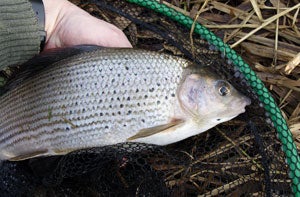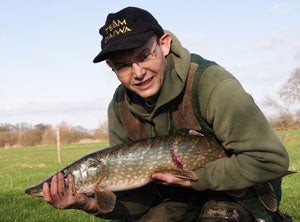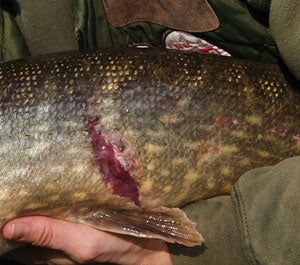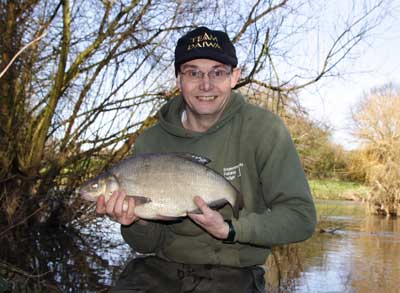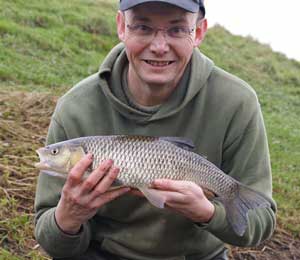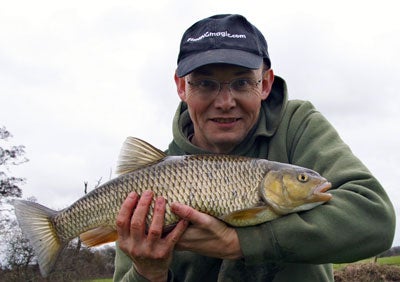| MARK WINTLE | |
Are you stuck in a rut fishing the same swim every week? Do you dare to try something different and see a whole new world of angling open up? Yes? Then read Mark Wintle’s regular column. |
Location, location, locationSometimes in fishing, knowing exactly where, what and when can make a big difference to your results. I don’t find much spare time for my fishing so getting results quickly, especially in winter when the days are short, helps to avoid wasting valuable fishing time. My quest for a big roach started this off, but in the weeks that followed the big roach were distinctly reluctant to play ball. By the end of January the topsy-turvy conditions persuaded me to target whatever seemed to offer the best prospects each weekend.As the Stour settled, the roach became less prominent and chub started to show with ever-increasing regularity but they were only part of what was about. I’d like to take you through a brief summary of these targeted trips; it’s surprising how short yet focussed sessions can be successful. A bonus big graylingBack in early November, I had a quick scout around on a club stretch of the Dorset Frome. It was producing some big grayling and I noted likely holding spots. In the weeks that followed, the floods came and it became unfishable but a dry spell over Christmas allowed it to settle. On New Year’s day, I was fishing a nearby lake catching plenty of small fish yet not especially getting into the fishing. A chance remark from a mate there soon resolved my dilemma. Quickly packing up, I was fishing one of the holding pools on the Frome less than twenty minutes later.
The powerful current was tricky but despite bumping two or three fish, it wasn’t long before I’d got the one I wanted in the net. A grayling that at 2lb 6oz was a new PB, and as it came from my home club water, means far more to me than one from some exclusive beat elsewhere. It was a cracker too, and an excellent way to start the New Year. A score to settle with a pikeThe swim that produced my two-pound roach had something larger lurking in the depths. In late December it had seized and bitten off a feeder and then one mid January morning it took two roach. With one of the seized roach I managed to get the pike almost to the net before it bit through the 2lb hooklength.
In late January I got some smelts and took my pike rod with me. After an hour getting the odd small roach I fixed a smelt to the trace and cast out to the spot where the pike seemed to lurk. A run wasn’t long in coming and after a spirited fight I put the net under an 11-pounder. I had hoped for something bigger but it was big enough. A large gash on its side had me wondering; was it otter damage or one of the numerous cormorants attacking it? Return visit to the bream holeFour years ago I had a go for the big bream in the lower part of Throop. In similar conditions – the river with a good tinge of colour and up slightly – I decided to pay a return visit. When I got to the swim, it was more challenging than ever.
Some roach at last, and the chub start to showThe upper Stour had to come right eventually and a week later it was just about perfect; only slightly above winter level with a tinge of colour, meaning it was time to find the roach for a change. I started with bread punch on a 16 that got me some net fish with one over a pound, but the feeding spell didn’t last long. Maggots can work just as well as bread for the better roach when the water is getting clear on the upper Stour. On Throop there tends to be more of a size differential between the two baits with bread consistently getting the bigger roach. I switched to a much smaller size 20 hook and started to fish and feed maggots. At first the roach were only little ‘uns but after a while the better ones reappeared and I ended up with about twenty roach.The roach swim is a deep one, a glide that is around eleven feet deep. Further upstream, there is a long pool that is only around five feet deep in normal conditions. At the tail of the pool where it shallows up for the rapids it is only three feet deep and a known chub-holding spot. Having made the move I changed to a size 18 hook and started to fish the tail swim. It wasn’t long before the chub showed but a duff hook meant that the first two fell off! I changed to a size 20 barbless and this did the trick. I landed the final two, both being just over three pounds. The weather gets colder, the river clears and the chub feedA week later, the dry weather in early February continued with overnight frosts. The river was finally below normal winter level and clear. With the hard frost in the morning, I decided to make a late start when it had warmed up. The river lacked the pace of earlier in the winter, and with no wind it was a pleasure to finally tackle up a light stick float with no. 8s and 10s down the line. I started in the pool where I’d left off the previous week, getting a decent chub first cast, shortly followed by another much smaller one. Then it dried up and I wandered off down the river looking for more likely chub swims. A couple of bends down there was another glide that I’d never bothered to fish, principally because I usually fish from the other bank where it is heavily overgrown. I made a mental note of the swim and continued further down. Despite trying three other swims I couldn’t get a bite so I returned to the glide. It certainly held chub for I hit six in total, landing four of around two to two and a half pounds with two coming adrift when they stuck their noses in sunken reeds. That was it for the day but I couldn’t help looking at a very fast shallow run below the first pool I’d fished. It holds chub in the summer when it’s very weedy, and it is normally much too fast in winter, but in the low water conditions and with the chub holding in shallow areas it held potential if the river continued to drop.Yet more chub a week laterThe conditions held a further week and I returned to the same stretch, planning to fish the morning on the Stour and then later on the Frome for grayling. A dumb pheasant broke my door mirror on the way to the river though so I scrapped the Frome part of the plan but another thought did cross my mind – more on than in a minute. I started where I left off the previous week; same swims, same tactics and some more chub – not the same ones though, and a new PB for the stretch of 3lb 10oz. What was clear was that there were a lot more chub in the stretch than I’d imagined. With that in mind, I decided to have a go at the rapid shallows. I retackled with a stubby waggler with just a no. 8 down the line and fed the swim for ten minutes. After that it was just like dace fishing except with chub as I landed fifteen chub in an hour, taking the morning’s total to eighteen.
That left time for an hour on a very fast and shallow swim much nearer home on the middle Stour. I hadn’t fished this swim for many years but knew its chub form. It’s a long cast so I tackled a 3AAA waggler with size 18 hook and started feeding it heavily with a catapult and maggots. It was easy fishing: cast, feed then control the float through the trot and repeat.
It took 40 minutes to get a bite, and when it came I had to hold tight as a big fish – likely a chub – tried repeatedly to get under the willow bush that I’d been trotting alongside. I moved down river so that I was slightly downstream of the fish and this did the trick after it had made half a dozen attempts to reach the snags. Once it was in mid river I had another problem; the chub was now in the very fast water below the glide and I needed it to come across the current. Eventually I got it in towards my bank but twice it saw the net that I was struggling to hold in the current. But third time lucky and it was in the net. There was a shallow backwater where I’d landed the chub and after unhooking I left the chub to recover in the net whilst I fetched scales and camera. The scales told me what I already knew – it was just over six pounds and my first six pounder on the float – better still, it didn’t come from Throop. Location, location, location – and simple fishingIt was only when looking at these results that the penny dropped. Week after week I had known where to fish, taking into consideration the conditions, and with some simple float fishing with bread or maggots, the pike excepted, caught the fish that I’d hoped for. The majority of them were far from headline-making monsters yet their fine condition and the enjoyable methods used to put them on the bank made it all very satisfying. In all of the cases I had made contact with the target fish in less than an hour but that was due to careful planning as much as luck.As the great man said ‘if you want to catch them you’ve got to find them first!’. |











